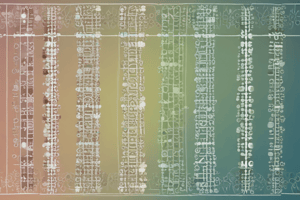Podcast
Questions and Answers
What is the primary function of genetics as a branch of science?
What is the primary function of genetics as a branch of science?
- To analyze the chemical composition of DNA
- To examine environmental impacts on evolution
- To understand inheritance and expression of genetic material (correct)
- To study the physical structure of the cell
Which of the following describes DNA?
Which of the following describes DNA?
- It is a polymer made up of nucleotides (correct)
- It exists as a single stranded molecule in all organisms
- It functions only as a carrier of energy in cells
- It is composed solely of amino acids
What type of bond forms between adenine and thymine in DNA?
What type of bond forms between adenine and thymine in DNA?
- Two hydrogen bonds (correct)
- Single covalent bond
- Three hydrogen bonds
- Ionic bond
What is the role of the phosphate group in DNA structure?
What is the role of the phosphate group in DNA structure?
Which statement about double-stranded DNA is correct?
Which statement about double-stranded DNA is correct?
How are nucleotides arranged in DNA?
How are nucleotides arranged in DNA?
Which pairing of nitrogenous bases is correctly matched based on their bonding?
Which pairing of nitrogenous bases is correctly matched based on their bonding?
How does DNA pack into chromosomes?
How does DNA pack into chromosomes?
What is the basic structural unit of chromatin?
What is the basic structural unit of chromatin?
Which of the following describes the organization of DNA in the nucleus during interphase?
Which of the following describes the organization of DNA in the nucleus during interphase?
What term refers to the DNA that is located between nucleosomes?
What term refers to the DNA that is located between nucleosomes?
How many chromosomes are present in a human somatic cell?
How many chromosomes are present in a human somatic cell?
What is the primary function of mitochondrial DNA?
What is the primary function of mitochondrial DNA?
What classification of chromosomes is based on the centromeric position?
What classification of chromosomes is based on the centromeric position?
What characterizes single copy DNA sequences in the nuclear genome?
What characterizes single copy DNA sequences in the nuclear genome?
What are the two main components of chromatin?
What are the two main components of chromatin?
During cell division, how are chromosomes structured?
During cell division, how are chromosomes structured?
What is the role of the histone protein H1 in chromatin?
What is the role of the histone protein H1 in chromatin?
Flashcards are hidden until you start studying
Study Notes
Genetics Overview
- Genetics studies the nature, transmission, and expression of genetic material.
- Medical Genetics focuses on inheritance, diagnosis, and treatment of genetically influenced diseases.
Genetic Material: DNA
- DNA (Deoxyribonucleic Acid) is the primary genetic material in cells.
- Structured as a polymer made of nucleotides comprising:
- Pentose sugar (deoxyribose)
- Nitrogenous bases (A, T, C, G)
- Phosphate group (negatively charged)
DNA Structure
- Nucleotides consist of:
- Purines: Adenine (A) and Guanine (G)
- Pyrimidines: Thymine (T) and Cytosine (C)
- Base pairing:
- A pairs with T via two hydrogen bonds
- C pairs with G via three hydrogen bonds
- DNA exists as single or double-stranded forming a double helix, with antiparallel strands (5’ to 3’ ends).
Measuring DNA
- Base pair (bp) is the basic unit for measuring DNA length.
- 1 kb (kilobase) equals 1000 bp.
Chromatin Packaging
- DNA is wrapped around histone proteins to form chromatin, with packaging levels:
- Nucleosome: DNA (140 bp) wraps around histones
- Solenoid: Coiling of nucleosomes into 30 nm fibers
- Loop domains: Loops of chromatin fibers bind to scaffolding proteins
Chromosome Structure
- Chromosomes consist of two sister chromatids joined at the centromere.
- Types of chromosomes based on centromeric position:
- Metacentric
- Submetacentric
- Acrocentric
Human Chromosome Characteristics
- Somatic cells contain 46 chromosomes (diploid, 2n), including 22 pairs of autosomes and 2 sex chromosomes.
- Germ cells (sperm and ova) contain 23 chromosomes (haploid, n), including 22 autosomes and 1 sex chromosome.
Human Genome Organization
- Human genome contains both nuclear DNA (in chromosomes) and mitochondrial DNA.
- Mitochondrial DNA:
- Circular and approximately 16 kb long
- Encodes 37 genes primarily for mitochondrial function, mainly ATP production
- Mitochondrial replication is controlled by nuclear DNA.
Nuclear Genome Structure
- Comprises single copy DNA sequences and repetitive DNA sequences.
- Single copy DNA includes protein-coding genes and regulatory elements, often present once or a few times.
- Repetitive DNA sequences are repeated extensively, aiding in chromosome structure and individual variation.
Suggested Readings
- "Genetics in Medicine" by Thompson and Thompson
- "Emery’s Elements of Medical Genetics"
- "Medical Genetics" (Ed.)
Studying That Suits You
Use AI to generate personalized quizzes and flashcards to suit your learning preferences.




